Management Accounting in Business: Tesco Financial Analysis Report
VerifiedAdded on 2020/12/30
|19
|5079
|283
Report
AI Summary
This report provides a detailed analysis of management accounting principles, focusing on the purpose of developing and presenting financial information to both internal and external stakeholders. The report explores the significance of financial information for companies like Tesco, emphasizing its role in decision-making, investment, and expansion. It examines various management accounting techniques, including cost accounting, cost-volume-profit analysis, and marginal and absorption costing, highlighting their impact on organizational performance and profitability. Furthermore, the report delves into the influence of internal and external business environments on management accounting practices. The report uses Tesco as a case study and analyzes how financial information is used by stakeholders such as board of directors, shareholders, banks, customers, creditors, and competitors. Overall, the report underscores the importance of accurate and clear financial information for the success and sustainable growth of a business entity.
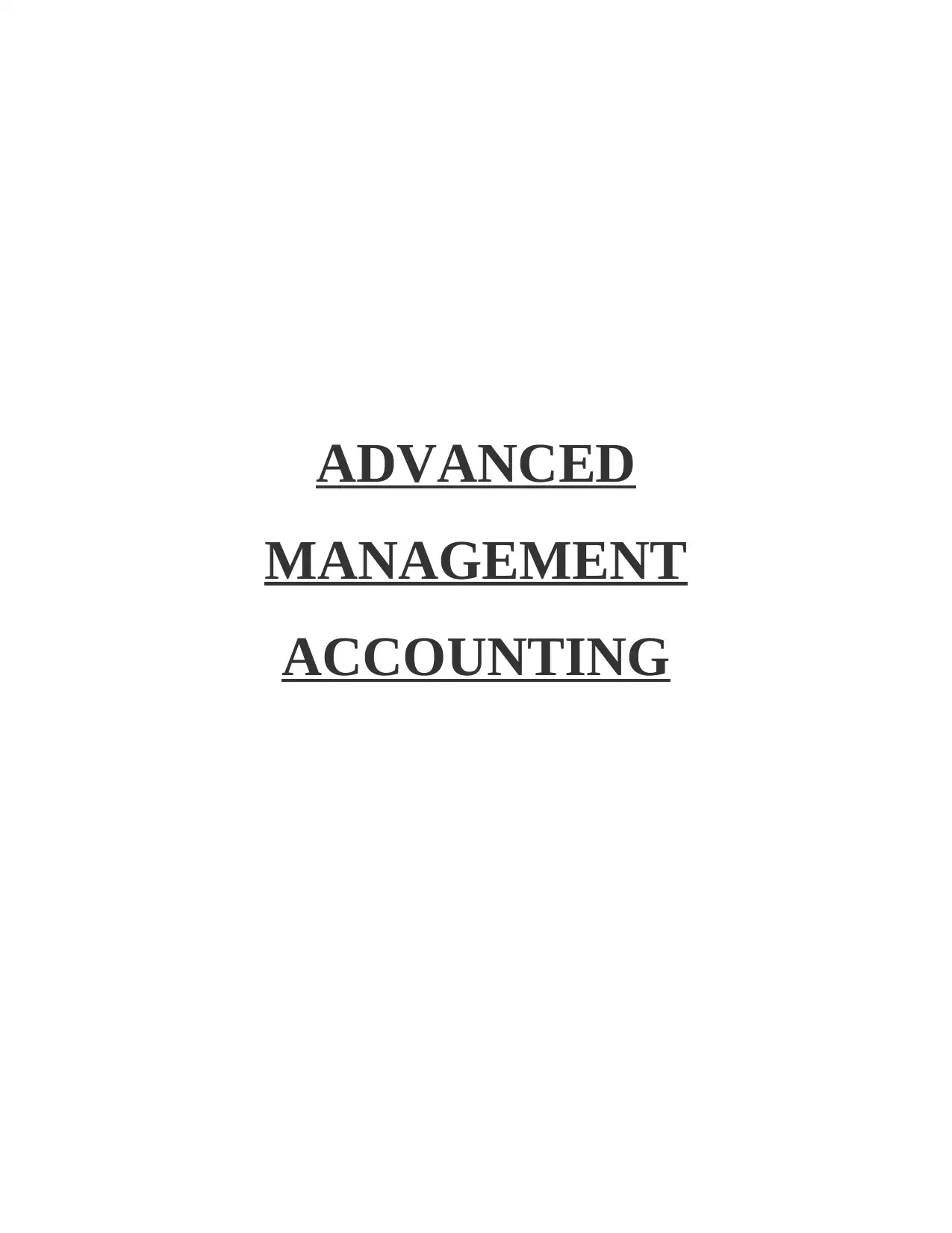
ADVANCED
MANAGEMENT
ACCOUNTING
MANAGEMENT
ACCOUNTING
Paraphrase This Document
Need a fresh take? Get an instant paraphrase of this document with our AI Paraphraser
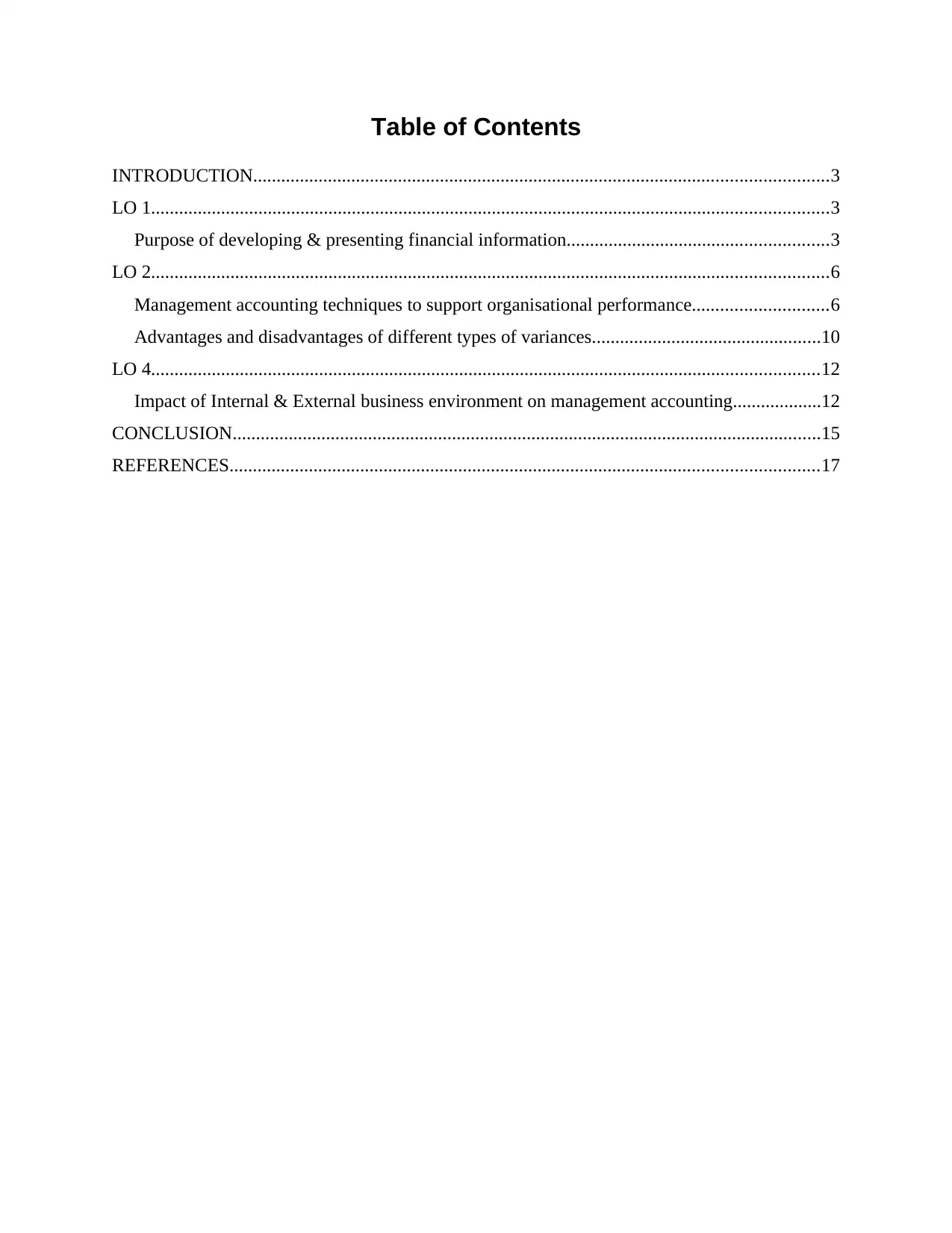
Table of Contents
INTRODUCTION...........................................................................................................................3
LO 1.................................................................................................................................................3
Purpose of developing & presenting financial information........................................................3
LO 2.................................................................................................................................................6
Management accounting techniques to support organisational performance.............................6
Advantages and disadvantages of different types of variances.................................................10
LO 4...............................................................................................................................................12
Impact of Internal & External business environment on management accounting...................12
CONCLUSION..............................................................................................................................15
REFERENCES..............................................................................................................................17
INTRODUCTION...........................................................................................................................3
LO 1.................................................................................................................................................3
Purpose of developing & presenting financial information........................................................3
LO 2.................................................................................................................................................6
Management accounting techniques to support organisational performance.............................6
Advantages and disadvantages of different types of variances.................................................10
LO 4...............................................................................................................................................12
Impact of Internal & External business environment on management accounting...................12
CONCLUSION..............................................................................................................................15
REFERENCES..............................................................................................................................17
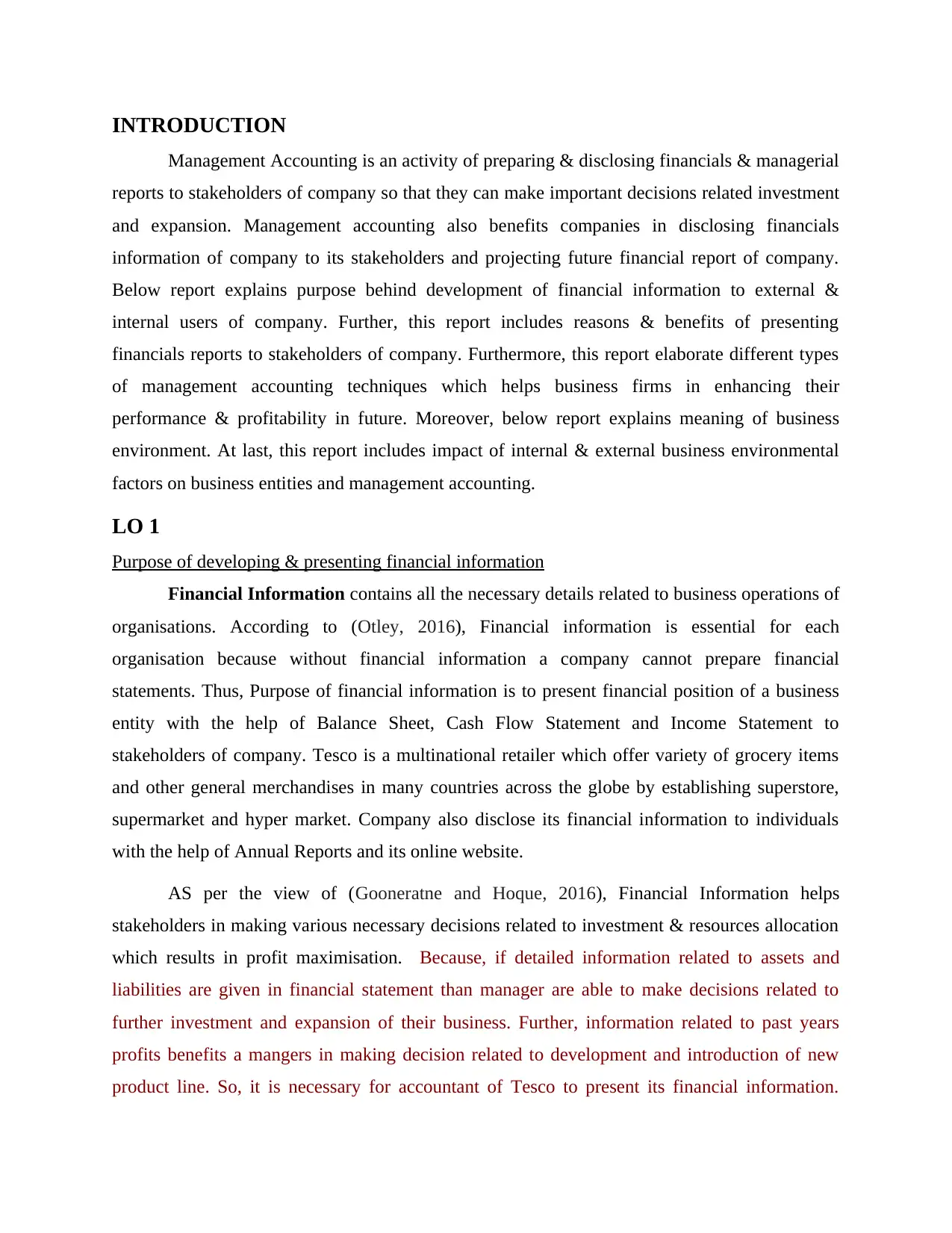
INTRODUCTION
Management Accounting is an activity of preparing & disclosing financials & managerial
reports to stakeholders of company so that they can make important decisions related investment
and expansion. Management accounting also benefits companies in disclosing financials
information of company to its stakeholders and projecting future financial report of company.
Below report explains purpose behind development of financial information to external &
internal users of company. Further, this report includes reasons & benefits of presenting
financials reports to stakeholders of company. Furthermore, this report elaborate different types
of management accounting techniques which helps business firms in enhancing their
performance & profitability in future. Moreover, below report explains meaning of business
environment. At last, this report includes impact of internal & external business environmental
factors on business entities and management accounting.
LO 1
Purpose of developing & presenting financial information
Financial Information contains all the necessary details related to business operations of
organisations. According to (Otley, 2016), Financial information is essential for each
organisation because without financial information a company cannot prepare financial
statements. Thus, Purpose of financial information is to present financial position of a business
entity with the help of Balance Sheet, Cash Flow Statement and Income Statement to
stakeholders of company. Tesco is a multinational retailer which offer variety of grocery items
and other general merchandises in many countries across the globe by establishing superstore,
supermarket and hyper market. Company also disclose its financial information to individuals
with the help of Annual Reports and its online website.
AS per the view of (Gooneratne and Hoque, 2016), Financial Information helps
stakeholders in making various necessary decisions related to investment & resources allocation
which results in profit maximisation. Because, if detailed information related to assets and
liabilities are given in financial statement than manager are able to make decisions related to
further investment and expansion of their business. Further, information related to past years
profits benefits a mangers in making decision related to development and introduction of new
product line. So, it is necessary for accountant of Tesco to present its financial information.
Management Accounting is an activity of preparing & disclosing financials & managerial
reports to stakeholders of company so that they can make important decisions related investment
and expansion. Management accounting also benefits companies in disclosing financials
information of company to its stakeholders and projecting future financial report of company.
Below report explains purpose behind development of financial information to external &
internal users of company. Further, this report includes reasons & benefits of presenting
financials reports to stakeholders of company. Furthermore, this report elaborate different types
of management accounting techniques which helps business firms in enhancing their
performance & profitability in future. Moreover, below report explains meaning of business
environment. At last, this report includes impact of internal & external business environmental
factors on business entities and management accounting.
LO 1
Purpose of developing & presenting financial information
Financial Information contains all the necessary details related to business operations of
organisations. According to (Otley, 2016), Financial information is essential for each
organisation because without financial information a company cannot prepare financial
statements. Thus, Purpose of financial information is to present financial position of a business
entity with the help of Balance Sheet, Cash Flow Statement and Income Statement to
stakeholders of company. Tesco is a multinational retailer which offer variety of grocery items
and other general merchandises in many countries across the globe by establishing superstore,
supermarket and hyper market. Company also disclose its financial information to individuals
with the help of Annual Reports and its online website.
AS per the view of (Gooneratne and Hoque, 2016), Financial Information helps
stakeholders in making various necessary decisions related to investment & resources allocation
which results in profit maximisation. Because, if detailed information related to assets and
liabilities are given in financial statement than manager are able to make decisions related to
further investment and expansion of their business. Further, information related to past years
profits benefits a mangers in making decision related to development and introduction of new
product line. So, it is necessary for accountant of Tesco to present its financial information.
⊘ This is a preview!⊘
Do you want full access?
Subscribe today to unlock all pages.

Trusted by 1+ million students worldwide
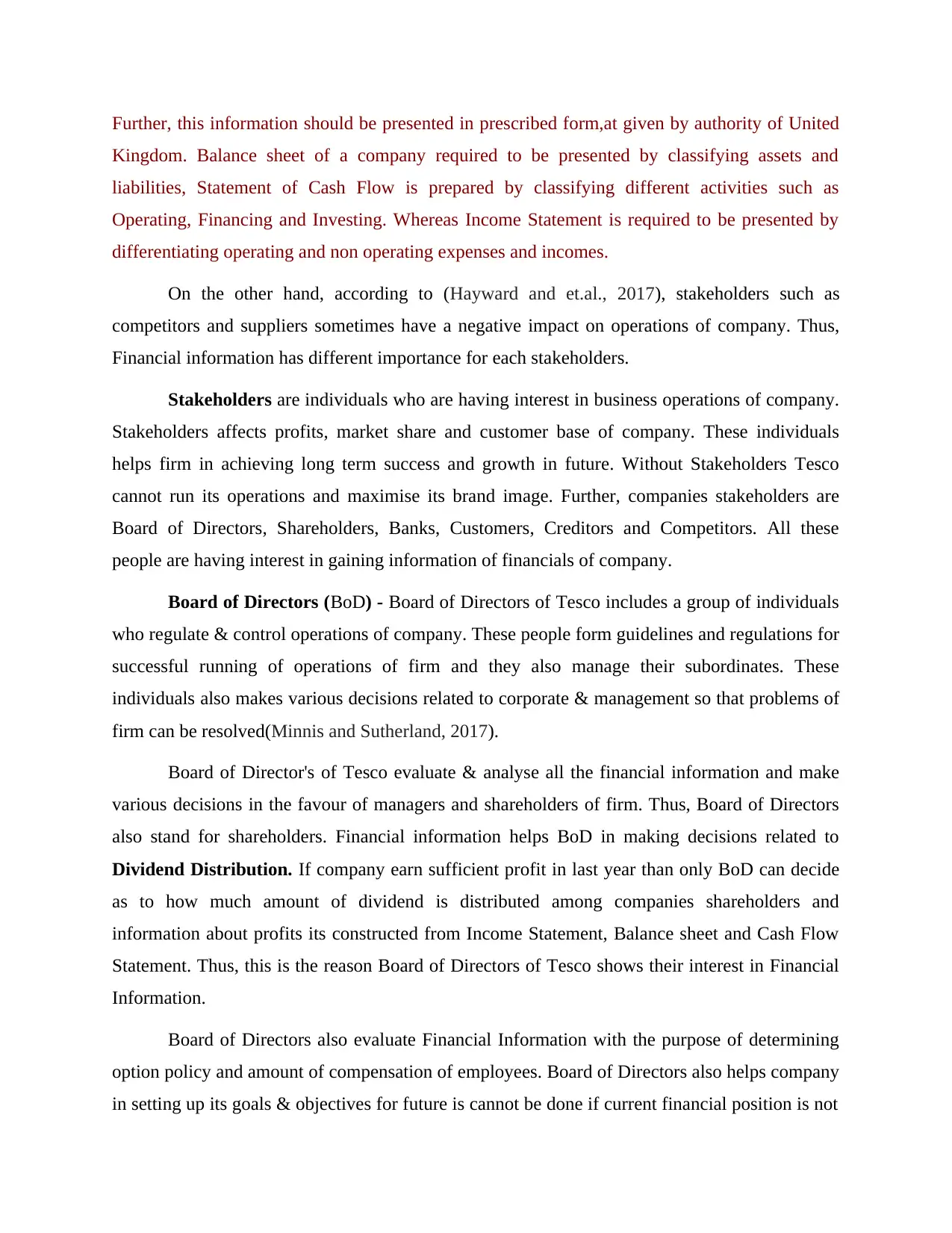
Further, this information should be presented in prescribed form,at given by authority of United
Kingdom. Balance sheet of a company required to be presented by classifying assets and
liabilities, Statement of Cash Flow is prepared by classifying different activities such as
Operating, Financing and Investing. Whereas Income Statement is required to be presented by
differentiating operating and non operating expenses and incomes.
On the other hand, according to (Hayward and et.al., 2017), stakeholders such as
competitors and suppliers sometimes have a negative impact on operations of company. Thus,
Financial information has different importance for each stakeholders.
Stakeholders are individuals who are having interest in business operations of company.
Stakeholders affects profits, market share and customer base of company. These individuals
helps firm in achieving long term success and growth in future. Without Stakeholders Tesco
cannot run its operations and maximise its brand image. Further, companies stakeholders are
Board of Directors, Shareholders, Banks, Customers, Creditors and Competitors. All these
people are having interest in gaining information of financials of company.
Board of Directors (BoD) - Board of Directors of Tesco includes a group of individuals
who regulate & control operations of company. These people form guidelines and regulations for
successful running of operations of firm and they also manage their subordinates. These
individuals also makes various decisions related to corporate & management so that problems of
firm can be resolved(Minnis and Sutherland, 2017).
Board of Director's of Tesco evaluate & analyse all the financial information and make
various decisions in the favour of managers and shareholders of firm. Thus, Board of Directors
also stand for shareholders. Financial information helps BoD in making decisions related to
Dividend Distribution. If company earn sufficient profit in last year than only BoD can decide
as to how much amount of dividend is distributed among companies shareholders and
information about profits its constructed from Income Statement, Balance sheet and Cash Flow
Statement. Thus, this is the reason Board of Directors of Tesco shows their interest in Financial
Information.
Board of Directors also evaluate Financial Information with the purpose of determining
option policy and amount of compensation of employees. Board of Directors also helps company
in setting up its goals & objectives for future is cannot be done if current financial position is not
Kingdom. Balance sheet of a company required to be presented by classifying assets and
liabilities, Statement of Cash Flow is prepared by classifying different activities such as
Operating, Financing and Investing. Whereas Income Statement is required to be presented by
differentiating operating and non operating expenses and incomes.
On the other hand, according to (Hayward and et.al., 2017), stakeholders such as
competitors and suppliers sometimes have a negative impact on operations of company. Thus,
Financial information has different importance for each stakeholders.
Stakeholders are individuals who are having interest in business operations of company.
Stakeholders affects profits, market share and customer base of company. These individuals
helps firm in achieving long term success and growth in future. Without Stakeholders Tesco
cannot run its operations and maximise its brand image. Further, companies stakeholders are
Board of Directors, Shareholders, Banks, Customers, Creditors and Competitors. All these
people are having interest in gaining information of financials of company.
Board of Directors (BoD) - Board of Directors of Tesco includes a group of individuals
who regulate & control operations of company. These people form guidelines and regulations for
successful running of operations of firm and they also manage their subordinates. These
individuals also makes various decisions related to corporate & management so that problems of
firm can be resolved(Minnis and Sutherland, 2017).
Board of Director's of Tesco evaluate & analyse all the financial information and make
various decisions in the favour of managers and shareholders of firm. Thus, Board of Directors
also stand for shareholders. Financial information helps BoD in making decisions related to
Dividend Distribution. If company earn sufficient profit in last year than only BoD can decide
as to how much amount of dividend is distributed among companies shareholders and
information about profits its constructed from Income Statement, Balance sheet and Cash Flow
Statement. Thus, this is the reason Board of Directors of Tesco shows their interest in Financial
Information.
Board of Directors also evaluate Financial Information with the purpose of determining
option policy and amount of compensation of employees. Board of Directors also helps company
in setting up its goals & objectives for future is cannot be done if current financial position is not
Paraphrase This Document
Need a fresh take? Get an instant paraphrase of this document with our AI Paraphraser
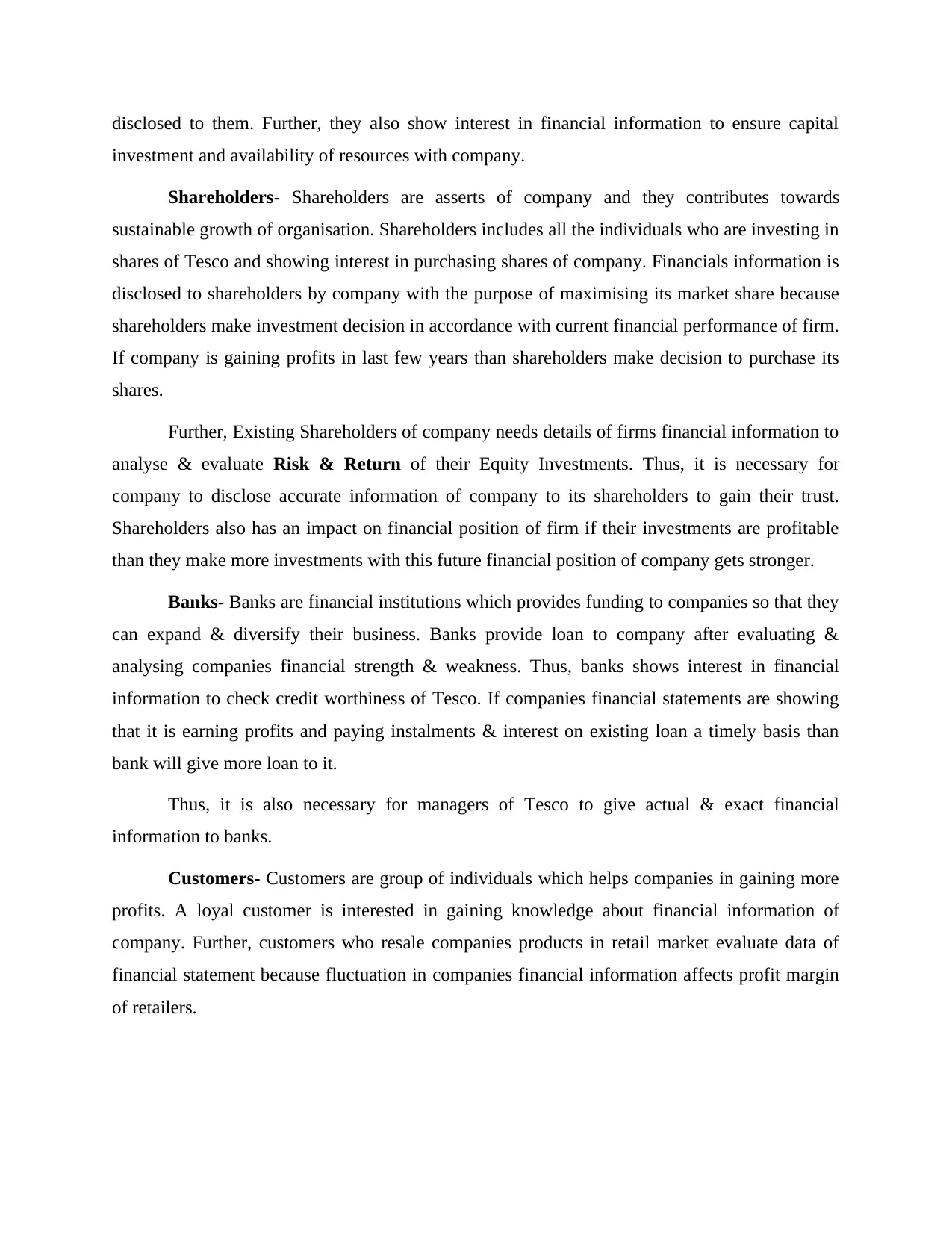
disclosed to them. Further, they also show interest in financial information to ensure capital
investment and availability of resources with company.
Shareholders- Shareholders are asserts of company and they contributes towards
sustainable growth of organisation. Shareholders includes all the individuals who are investing in
shares of Tesco and showing interest in purchasing shares of company. Financials information is
disclosed to shareholders by company with the purpose of maximising its market share because
shareholders make investment decision in accordance with current financial performance of firm.
If company is gaining profits in last few years than shareholders make decision to purchase its
shares.
Further, Existing Shareholders of company needs details of firms financial information to
analyse & evaluate Risk & Return of their Equity Investments. Thus, it is necessary for
company to disclose accurate information of company to its shareholders to gain their trust.
Shareholders also has an impact on financial position of firm if their investments are profitable
than they make more investments with this future financial position of company gets stronger.
Banks- Banks are financial institutions which provides funding to companies so that they
can expand & diversify their business. Banks provide loan to company after evaluating &
analysing companies financial strength & weakness. Thus, banks shows interest in financial
information to check credit worthiness of Tesco. If companies financial statements are showing
that it is earning profits and paying instalments & interest on existing loan a timely basis than
bank will give more loan to it.
Thus, it is also necessary for managers of Tesco to give actual & exact financial
information to banks.
Customers- Customers are group of individuals which helps companies in gaining more
profits. A loyal customer is interested in gaining knowledge about financial information of
company. Further, customers who resale companies products in retail market evaluate data of
financial statement because fluctuation in companies financial information affects profit margin
of retailers.
investment and availability of resources with company.
Shareholders- Shareholders are asserts of company and they contributes towards
sustainable growth of organisation. Shareholders includes all the individuals who are investing in
shares of Tesco and showing interest in purchasing shares of company. Financials information is
disclosed to shareholders by company with the purpose of maximising its market share because
shareholders make investment decision in accordance with current financial performance of firm.
If company is gaining profits in last few years than shareholders make decision to purchase its
shares.
Further, Existing Shareholders of company needs details of firms financial information to
analyse & evaluate Risk & Return of their Equity Investments. Thus, it is necessary for
company to disclose accurate information of company to its shareholders to gain their trust.
Shareholders also has an impact on financial position of firm if their investments are profitable
than they make more investments with this future financial position of company gets stronger.
Banks- Banks are financial institutions which provides funding to companies so that they
can expand & diversify their business. Banks provide loan to company after evaluating &
analysing companies financial strength & weakness. Thus, banks shows interest in financial
information to check credit worthiness of Tesco. If companies financial statements are showing
that it is earning profits and paying instalments & interest on existing loan a timely basis than
bank will give more loan to it.
Thus, it is also necessary for managers of Tesco to give actual & exact financial
information to banks.
Customers- Customers are group of individuals which helps companies in gaining more
profits. A loyal customer is interested in gaining knowledge about financial information of
company. Further, customers who resale companies products in retail market evaluate data of
financial statement because fluctuation in companies financial information affects profit margin
of retailers.
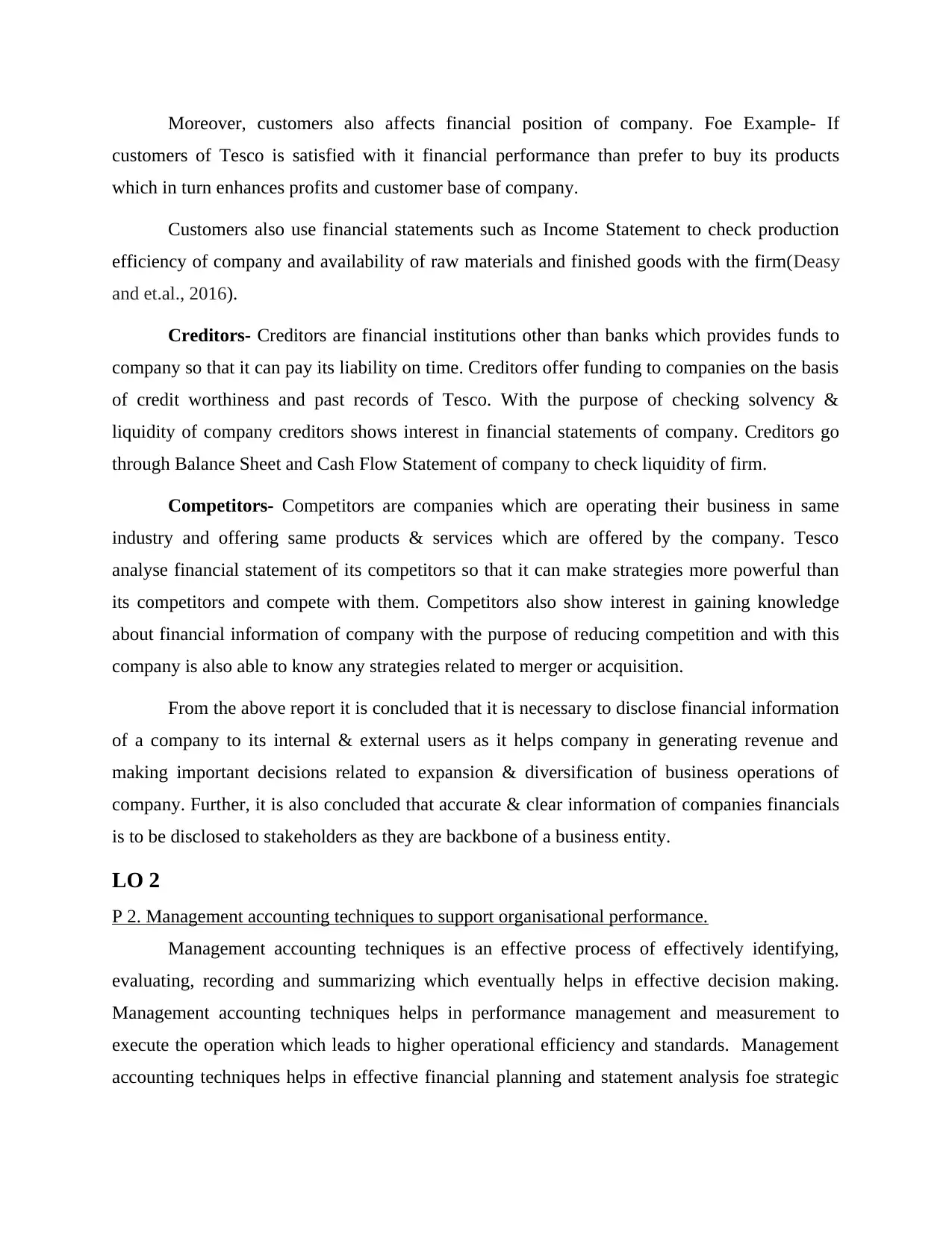
Moreover, customers also affects financial position of company. Foe Example- If
customers of Tesco is satisfied with it financial performance than prefer to buy its products
which in turn enhances profits and customer base of company.
Customers also use financial statements such as Income Statement to check production
efficiency of company and availability of raw materials and finished goods with the firm(Deasy
and et.al., 2016).
Creditors- Creditors are financial institutions other than banks which provides funds to
company so that it can pay its liability on time. Creditors offer funding to companies on the basis
of credit worthiness and past records of Tesco. With the purpose of checking solvency &
liquidity of company creditors shows interest in financial statements of company. Creditors go
through Balance Sheet and Cash Flow Statement of company to check liquidity of firm.
Competitors- Competitors are companies which are operating their business in same
industry and offering same products & services which are offered by the company. Tesco
analyse financial statement of its competitors so that it can make strategies more powerful than
its competitors and compete with them. Competitors also show interest in gaining knowledge
about financial information of company with the purpose of reducing competition and with this
company is also able to know any strategies related to merger or acquisition.
From the above report it is concluded that it is necessary to disclose financial information
of a company to its internal & external users as it helps company in generating revenue and
making important decisions related to expansion & diversification of business operations of
company. Further, it is also concluded that accurate & clear information of companies financials
is to be disclosed to stakeholders as they are backbone of a business entity.
LO 2
P 2. Management accounting techniques to support organisational performance.
Management accounting techniques is an effective process of effectively identifying,
evaluating, recording and summarizing which eventually helps in effective decision making.
Management accounting techniques helps in performance management and measurement to
execute the operation which leads to higher operational efficiency and standards. Management
accounting techniques helps in effective financial planning and statement analysis foe strategic
customers of Tesco is satisfied with it financial performance than prefer to buy its products
which in turn enhances profits and customer base of company.
Customers also use financial statements such as Income Statement to check production
efficiency of company and availability of raw materials and finished goods with the firm(Deasy
and et.al., 2016).
Creditors- Creditors are financial institutions other than banks which provides funds to
company so that it can pay its liability on time. Creditors offer funding to companies on the basis
of credit worthiness and past records of Tesco. With the purpose of checking solvency &
liquidity of company creditors shows interest in financial statements of company. Creditors go
through Balance Sheet and Cash Flow Statement of company to check liquidity of firm.
Competitors- Competitors are companies which are operating their business in same
industry and offering same products & services which are offered by the company. Tesco
analyse financial statement of its competitors so that it can make strategies more powerful than
its competitors and compete with them. Competitors also show interest in gaining knowledge
about financial information of company with the purpose of reducing competition and with this
company is also able to know any strategies related to merger or acquisition.
From the above report it is concluded that it is necessary to disclose financial information
of a company to its internal & external users as it helps company in generating revenue and
making important decisions related to expansion & diversification of business operations of
company. Further, it is also concluded that accurate & clear information of companies financials
is to be disclosed to stakeholders as they are backbone of a business entity.
LO 2
P 2. Management accounting techniques to support organisational performance.
Management accounting techniques is an effective process of effectively identifying,
evaluating, recording and summarizing which eventually helps in effective decision making.
Management accounting techniques helps in performance management and measurement to
execute the operation which leads to higher operational efficiency and standards. Management
accounting techniques helps in effective financial planning and statement analysis foe strategic
⊘ This is a preview!⊘
Do you want full access?
Subscribe today to unlock all pages.

Trusted by 1+ million students worldwide
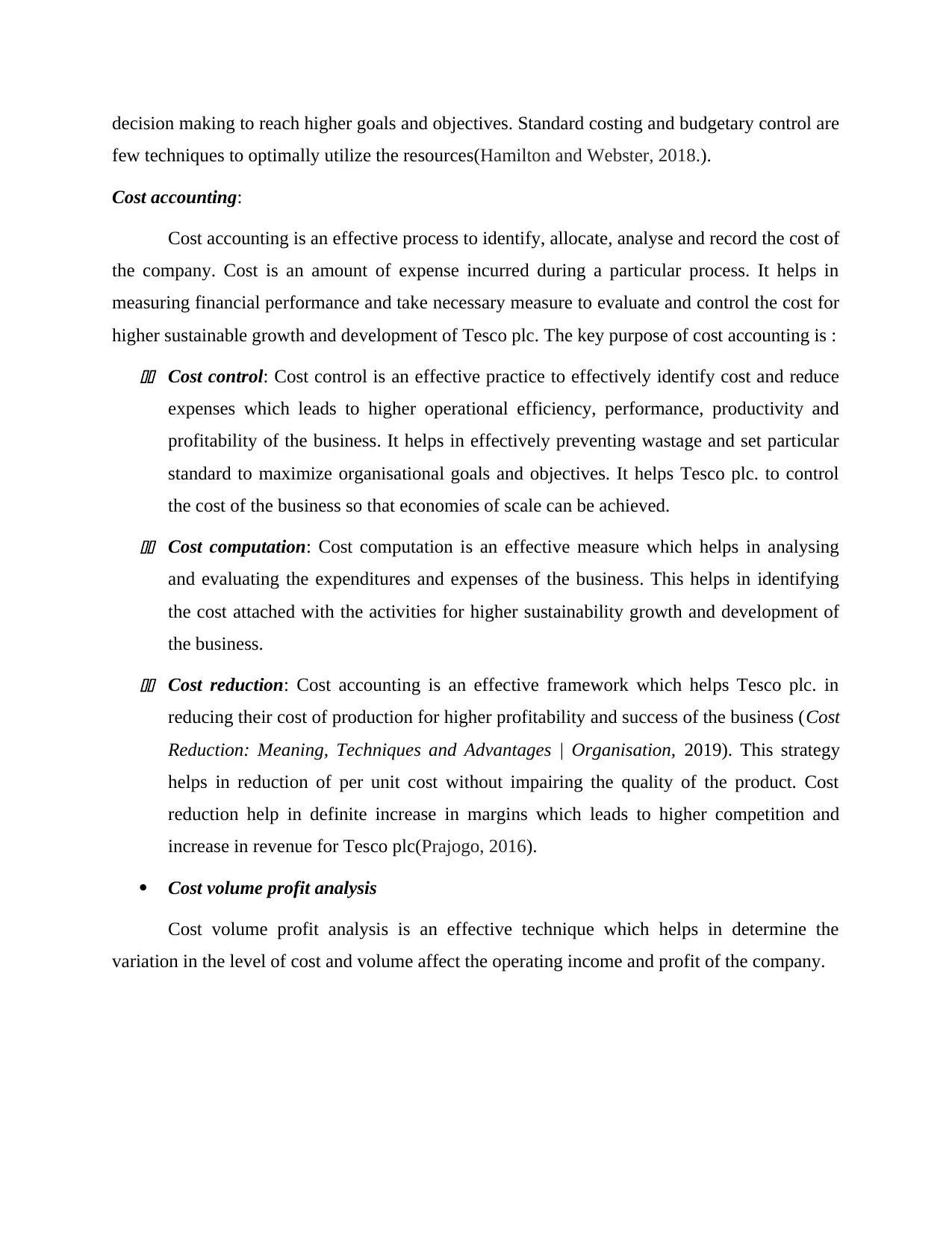
decision making to reach higher goals and objectives. Standard costing and budgetary control are
few techniques to optimally utilize the resources(Hamilton and Webster, 2018.).
Cost accounting:
Cost accounting is an effective process to identify, allocate, analyse and record the cost of
the company. Cost is an amount of expense incurred during a particular process. It helps in
measuring financial performance and take necessary measure to evaluate and control the cost for
higher sustainable growth and development of Tesco plc. The key purpose of cost accounting is :11 Cost control: Cost control is an effective practice to effectively identify cost and reduce
expenses which leads to higher operational efficiency, performance, productivity and
profitability of the business. It helps in effectively preventing wastage and set particular
standard to maximize organisational goals and objectives. It helps Tesco plc. to control
the cost of the business so that economies of scale can be achieved.11 Cost computation: Cost computation is an effective measure which helps in analysing
and evaluating the expenditures and expenses of the business. This helps in identifying
the cost attached with the activities for higher sustainability growth and development of
the business.11 Cost reduction: Cost accounting is an effective framework which helps Tesco plc. in
reducing their cost of production for higher profitability and success of the business (Cost
Reduction: Meaning, Techniques and Advantages | Organisation, 2019). This strategy
helps in reduction of per unit cost without impairing the quality of the product. Cost
reduction help in definite increase in margins which leads to higher competition and
increase in revenue for Tesco plc(Prajogo, 2016).
Cost volume profit analysis
Cost volume profit analysis is an effective technique which helps in determine the
variation in the level of cost and volume affect the operating income and profit of the company.
few techniques to optimally utilize the resources(Hamilton and Webster, 2018.).
Cost accounting:
Cost accounting is an effective process to identify, allocate, analyse and record the cost of
the company. Cost is an amount of expense incurred during a particular process. It helps in
measuring financial performance and take necessary measure to evaluate and control the cost for
higher sustainable growth and development of Tesco plc. The key purpose of cost accounting is :11 Cost control: Cost control is an effective practice to effectively identify cost and reduce
expenses which leads to higher operational efficiency, performance, productivity and
profitability of the business. It helps in effectively preventing wastage and set particular
standard to maximize organisational goals and objectives. It helps Tesco plc. to control
the cost of the business so that economies of scale can be achieved.11 Cost computation: Cost computation is an effective measure which helps in analysing
and evaluating the expenditures and expenses of the business. This helps in identifying
the cost attached with the activities for higher sustainability growth and development of
the business.11 Cost reduction: Cost accounting is an effective framework which helps Tesco plc. in
reducing their cost of production for higher profitability and success of the business (Cost
Reduction: Meaning, Techniques and Advantages | Organisation, 2019). This strategy
helps in reduction of per unit cost without impairing the quality of the product. Cost
reduction help in definite increase in margins which leads to higher competition and
increase in revenue for Tesco plc(Prajogo, 2016).
Cost volume profit analysis
Cost volume profit analysis is an effective technique which helps in determine the
variation in the level of cost and volume affect the operating income and profit of the company.
Paraphrase This Document
Need a fresh take? Get an instant paraphrase of this document with our AI Paraphraser
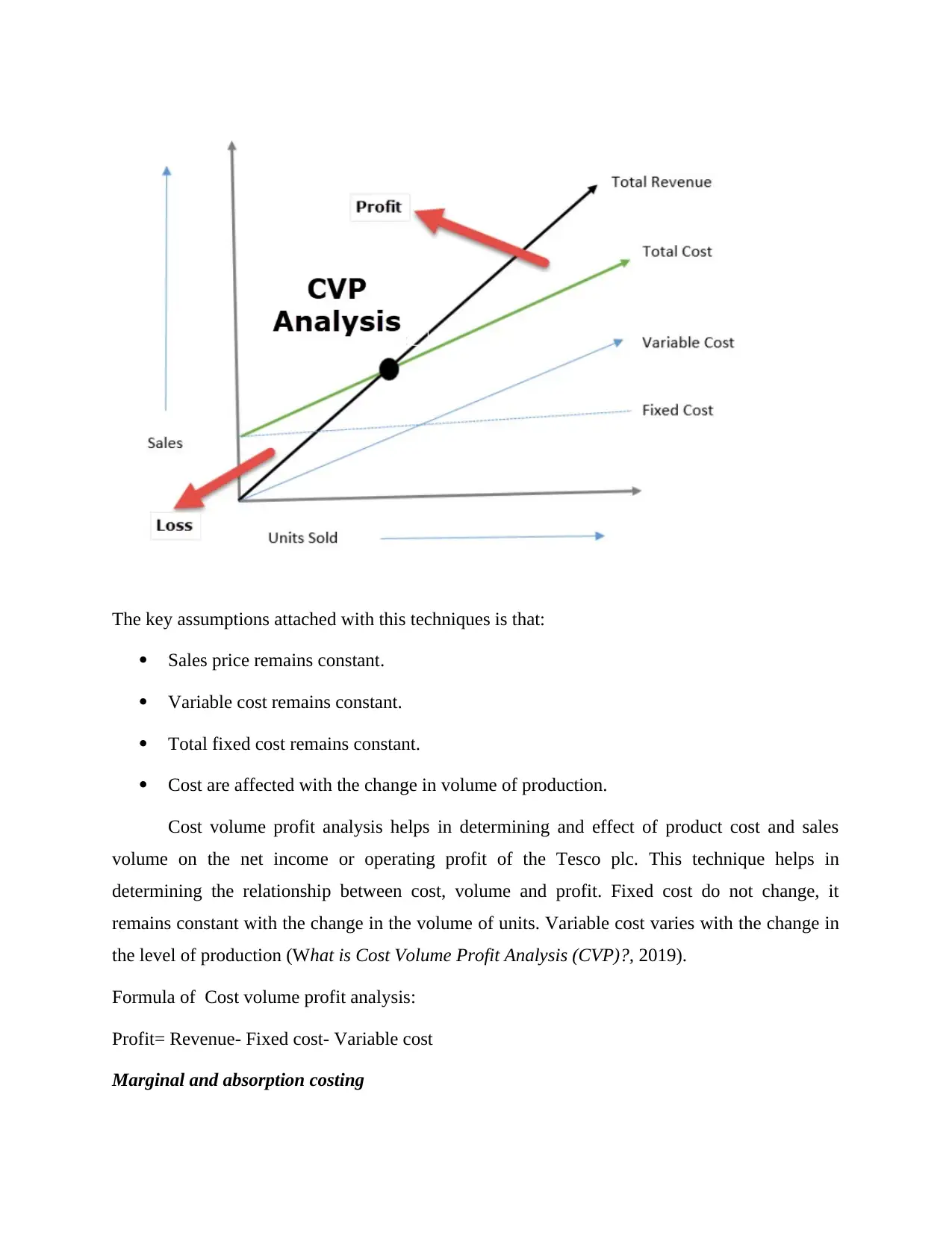
The key assumptions attached with this techniques is that:
Sales price remains constant.
Variable cost remains constant.
Total fixed cost remains constant.
Cost are affected with the change in volume of production.
Cost volume profit analysis helps in determining and effect of product cost and sales
volume on the net income or operating profit of the Tesco plc. This technique helps in
determining the relationship between cost, volume and profit. Fixed cost do not change, it
remains constant with the change in the volume of units. Variable cost varies with the change in
the level of production (What is Cost Volume Profit Analysis (CVP)?, 2019).
Formula of Cost volume profit analysis:
Profit= Revenue- Fixed cost- Variable cost
Marginal and absorption costing
Sales price remains constant.
Variable cost remains constant.
Total fixed cost remains constant.
Cost are affected with the change in volume of production.
Cost volume profit analysis helps in determining and effect of product cost and sales
volume on the net income or operating profit of the Tesco plc. This technique helps in
determining the relationship between cost, volume and profit. Fixed cost do not change, it
remains constant with the change in the volume of units. Variable cost varies with the change in
the level of production (What is Cost Volume Profit Analysis (CVP)?, 2019).
Formula of Cost volume profit analysis:
Profit= Revenue- Fixed cost- Variable cost
Marginal and absorption costing
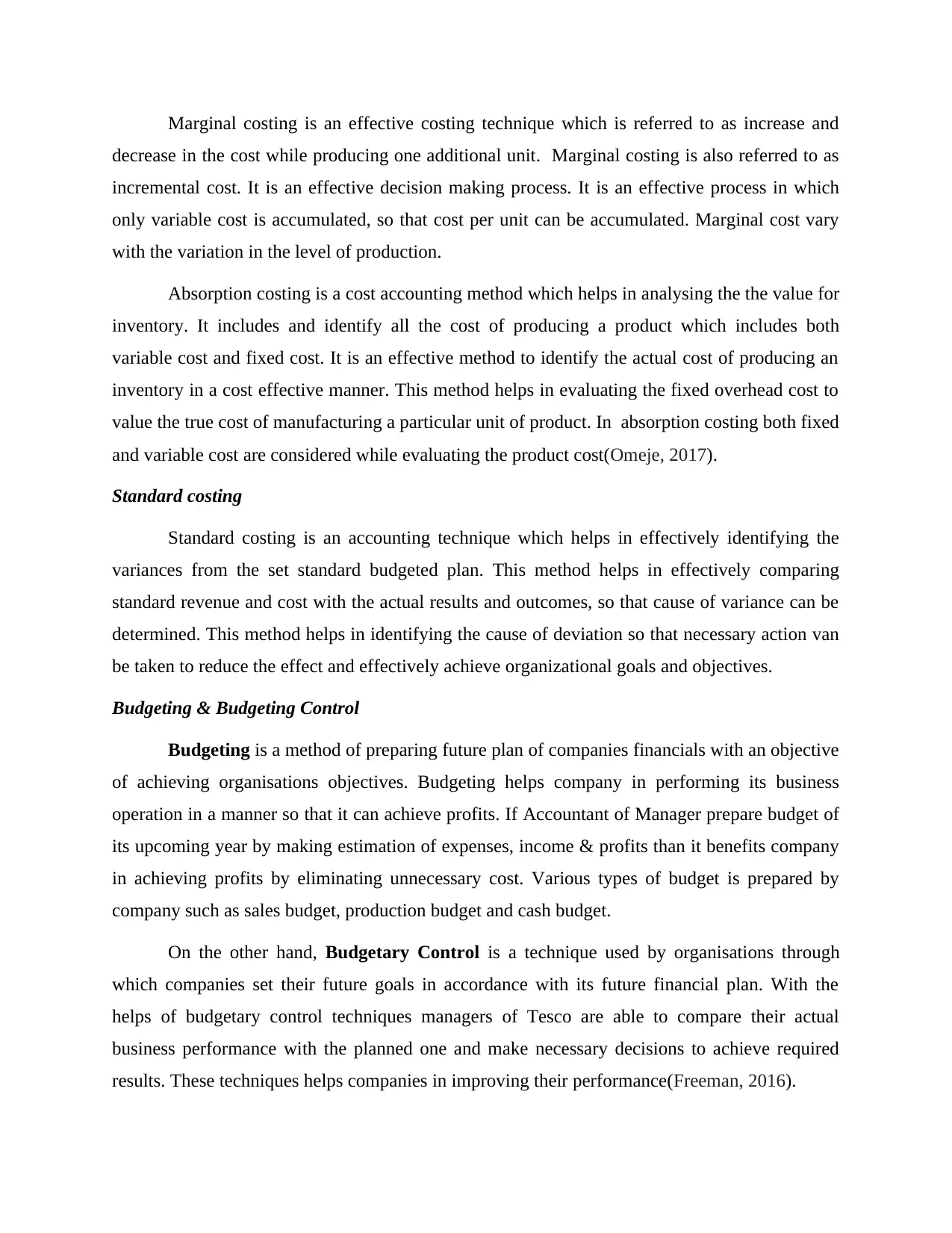
Marginal costing is an effective costing technique which is referred to as increase and
decrease in the cost while producing one additional unit. Marginal costing is also referred to as
incremental cost. It is an effective decision making process. It is an effective process in which
only variable cost is accumulated, so that cost per unit can be accumulated. Marginal cost vary
with the variation in the level of production.
Absorption costing is a cost accounting method which helps in analysing the the value for
inventory. It includes and identify all the cost of producing a product which includes both
variable cost and fixed cost. It is an effective method to identify the actual cost of producing an
inventory in a cost effective manner. This method helps in evaluating the fixed overhead cost to
value the true cost of manufacturing a particular unit of product. In absorption costing both fixed
and variable cost are considered while evaluating the product cost(Omeje, 2017).
Standard costing
Standard costing is an accounting technique which helps in effectively identifying the
variances from the set standard budgeted plan. This method helps in effectively comparing
standard revenue and cost with the actual results and outcomes, so that cause of variance can be
determined. This method helps in identifying the cause of deviation so that necessary action van
be taken to reduce the effect and effectively achieve organizational goals and objectives.
Budgeting & Budgeting Control
Budgeting is a method of preparing future plan of companies financials with an objective
of achieving organisations objectives. Budgeting helps company in performing its business
operation in a manner so that it can achieve profits. If Accountant of Manager prepare budget of
its upcoming year by making estimation of expenses, income & profits than it benefits company
in achieving profits by eliminating unnecessary cost. Various types of budget is prepared by
company such as sales budget, production budget and cash budget.
On the other hand, Budgetary Control is a technique used by organisations through
which companies set their future goals in accordance with its future financial plan. With the
helps of budgetary control techniques managers of Tesco are able to compare their actual
business performance with the planned one and make necessary decisions to achieve required
results. These techniques helps companies in improving their performance(Freeman, 2016).
decrease in the cost while producing one additional unit. Marginal costing is also referred to as
incremental cost. It is an effective decision making process. It is an effective process in which
only variable cost is accumulated, so that cost per unit can be accumulated. Marginal cost vary
with the variation in the level of production.
Absorption costing is a cost accounting method which helps in analysing the the value for
inventory. It includes and identify all the cost of producing a product which includes both
variable cost and fixed cost. It is an effective method to identify the actual cost of producing an
inventory in a cost effective manner. This method helps in evaluating the fixed overhead cost to
value the true cost of manufacturing a particular unit of product. In absorption costing both fixed
and variable cost are considered while evaluating the product cost(Omeje, 2017).
Standard costing
Standard costing is an accounting technique which helps in effectively identifying the
variances from the set standard budgeted plan. This method helps in effectively comparing
standard revenue and cost with the actual results and outcomes, so that cause of variance can be
determined. This method helps in identifying the cause of deviation so that necessary action van
be taken to reduce the effect and effectively achieve organizational goals and objectives.
Budgeting & Budgeting Control
Budgeting is a method of preparing future plan of companies financials with an objective
of achieving organisations objectives. Budgeting helps company in performing its business
operation in a manner so that it can achieve profits. If Accountant of Manager prepare budget of
its upcoming year by making estimation of expenses, income & profits than it benefits company
in achieving profits by eliminating unnecessary cost. Various types of budget is prepared by
company such as sales budget, production budget and cash budget.
On the other hand, Budgetary Control is a technique used by organisations through
which companies set their future goals in accordance with its future financial plan. With the
helps of budgetary control techniques managers of Tesco are able to compare their actual
business performance with the planned one and make necessary decisions to achieve required
results. These techniques helps companies in improving their performance(Freeman, 2016).
⊘ This is a preview!⊘
Do you want full access?
Subscribe today to unlock all pages.

Trusted by 1+ million students worldwide
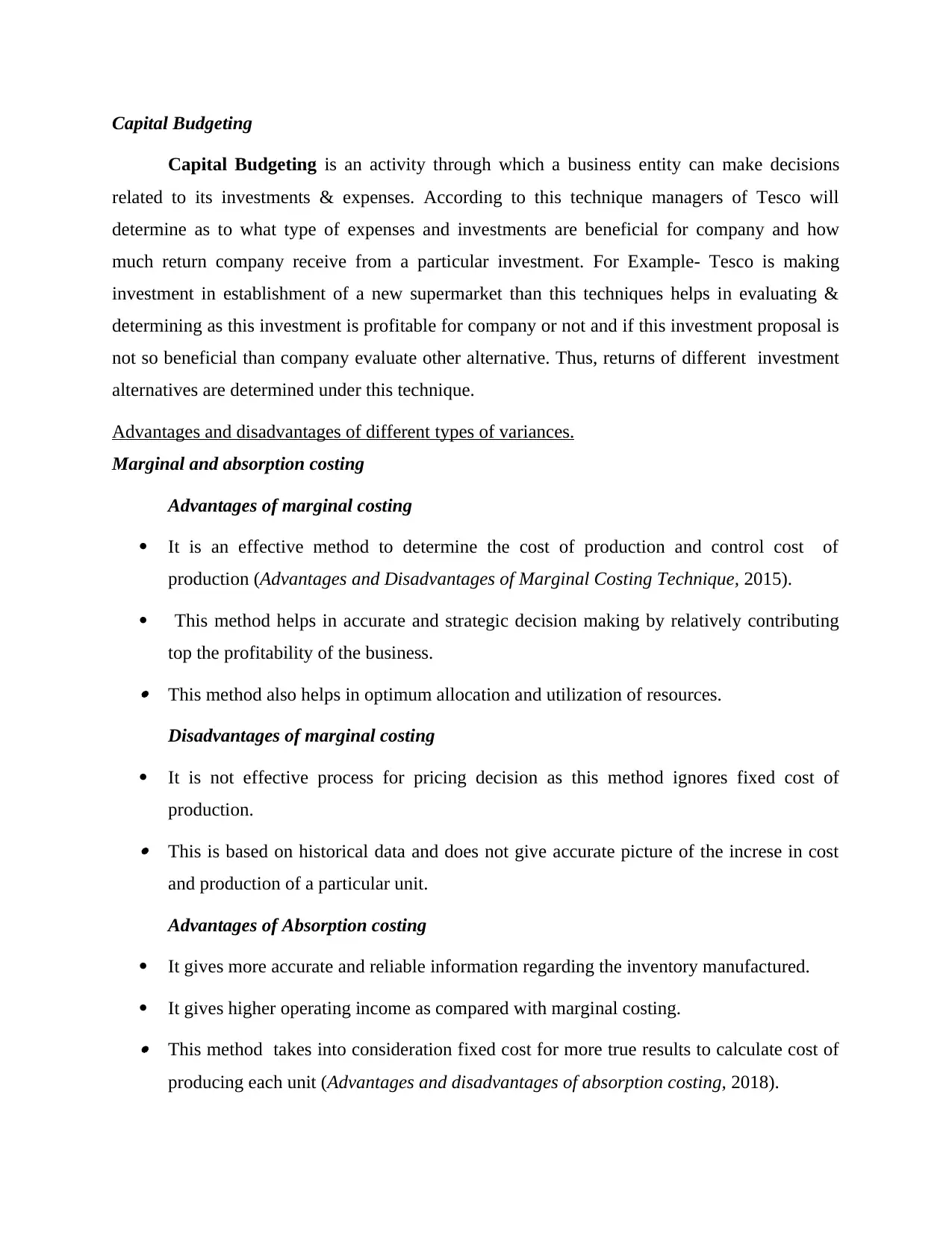
Capital Budgeting
Capital Budgeting is an activity through which a business entity can make decisions
related to its investments & expenses. According to this technique managers of Tesco will
determine as to what type of expenses and investments are beneficial for company and how
much return company receive from a particular investment. For Example- Tesco is making
investment in establishment of a new supermarket than this techniques helps in evaluating &
determining as this investment is profitable for company or not and if this investment proposal is
not so beneficial than company evaluate other alternative. Thus, returns of different investment
alternatives are determined under this technique.
Advantages and disadvantages of different types of variances.
Marginal and absorption costing
Advantages of marginal costing
It is an effective method to determine the cost of production and control cost of
production (Advantages and Disadvantages of Marginal Costing Technique, 2015).
This method helps in accurate and strategic decision making by relatively contributing
top the profitability of the business. This method also helps in optimum allocation and utilization of resources.
Disadvantages of marginal costing
It is not effective process for pricing decision as this method ignores fixed cost of
production. This is based on historical data and does not give accurate picture of the increse in cost
and production of a particular unit.
Advantages of Absorption costing
It gives more accurate and reliable information regarding the inventory manufactured.
It gives higher operating income as compared with marginal costing. This method takes into consideration fixed cost for more true results to calculate cost of
producing each unit (Advantages and disadvantages of absorption costing, 2018).
Capital Budgeting is an activity through which a business entity can make decisions
related to its investments & expenses. According to this technique managers of Tesco will
determine as to what type of expenses and investments are beneficial for company and how
much return company receive from a particular investment. For Example- Tesco is making
investment in establishment of a new supermarket than this techniques helps in evaluating &
determining as this investment is profitable for company or not and if this investment proposal is
not so beneficial than company evaluate other alternative. Thus, returns of different investment
alternatives are determined under this technique.
Advantages and disadvantages of different types of variances.
Marginal and absorption costing
Advantages of marginal costing
It is an effective method to determine the cost of production and control cost of
production (Advantages and Disadvantages of Marginal Costing Technique, 2015).
This method helps in accurate and strategic decision making by relatively contributing
top the profitability of the business. This method also helps in optimum allocation and utilization of resources.
Disadvantages of marginal costing
It is not effective process for pricing decision as this method ignores fixed cost of
production. This is based on historical data and does not give accurate picture of the increse in cost
and production of a particular unit.
Advantages of Absorption costing
It gives more accurate and reliable information regarding the inventory manufactured.
It gives higher operating income as compared with marginal costing. This method takes into consideration fixed cost for more true results to calculate cost of
producing each unit (Advantages and disadvantages of absorption costing, 2018).
Paraphrase This Document
Need a fresh take? Get an instant paraphrase of this document with our AI Paraphraser
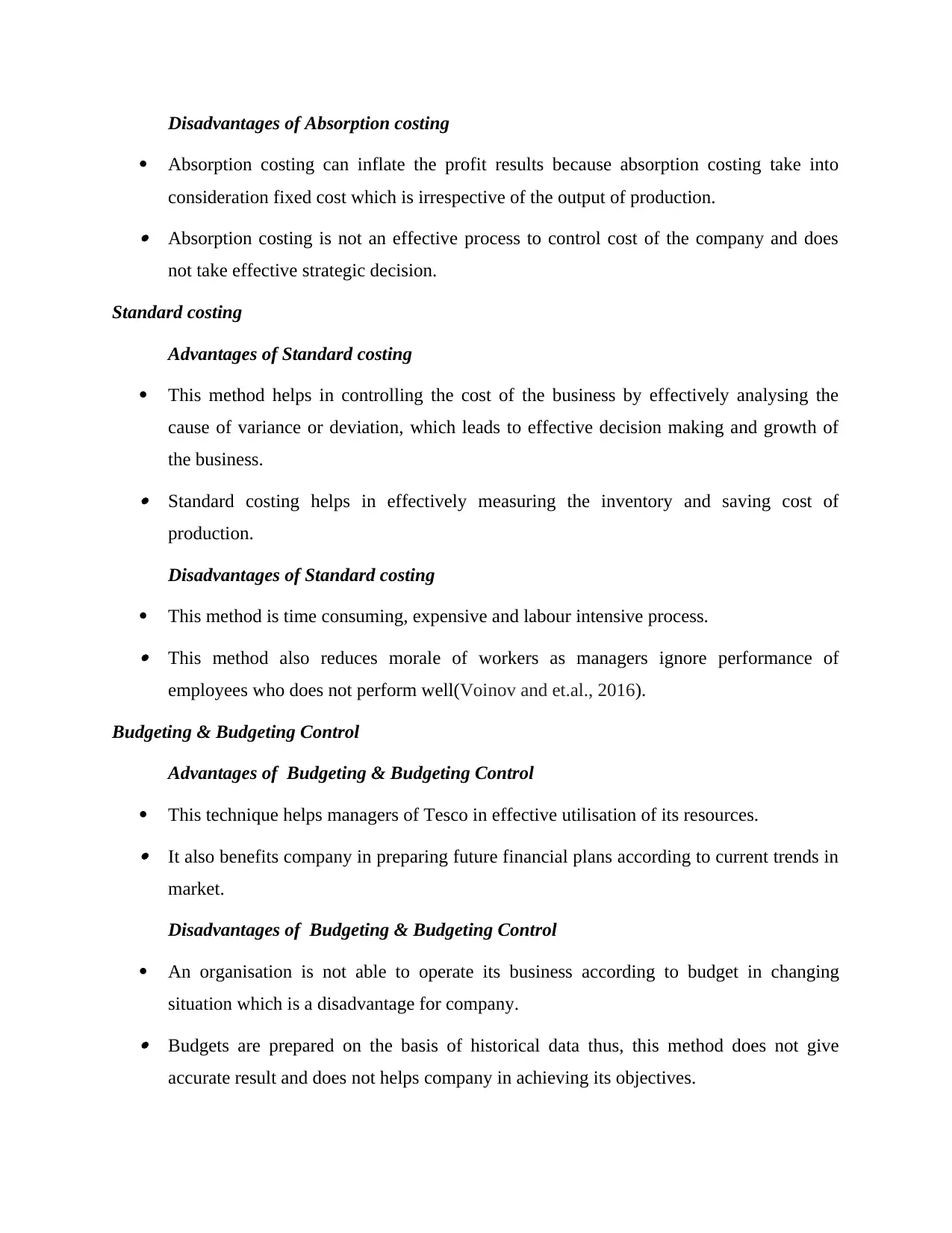
Disadvantages of Absorption costing
Absorption costing can inflate the profit results because absorption costing take into
consideration fixed cost which is irrespective of the output of production. Absorption costing is not an effective process to control cost of the company and does
not take effective strategic decision.
Standard costing
Advantages of Standard costing
This method helps in controlling the cost of the business by effectively analysing the
cause of variance or deviation, which leads to effective decision making and growth of
the business. Standard costing helps in effectively measuring the inventory and saving cost of
production.
Disadvantages of Standard costing
This method is time consuming, expensive and labour intensive process. This method also reduces morale of workers as managers ignore performance of
employees who does not perform well(Voinov and et.al., 2016).
Budgeting & Budgeting Control
Advantages of Budgeting & Budgeting Control
This technique helps managers of Tesco in effective utilisation of its resources. It also benefits company in preparing future financial plans according to current trends in
market.
Disadvantages of Budgeting & Budgeting Control
An organisation is not able to operate its business according to budget in changing
situation which is a disadvantage for company. Budgets are prepared on the basis of historical data thus, this method does not give
accurate result and does not helps company in achieving its objectives.
Absorption costing can inflate the profit results because absorption costing take into
consideration fixed cost which is irrespective of the output of production. Absorption costing is not an effective process to control cost of the company and does
not take effective strategic decision.
Standard costing
Advantages of Standard costing
This method helps in controlling the cost of the business by effectively analysing the
cause of variance or deviation, which leads to effective decision making and growth of
the business. Standard costing helps in effectively measuring the inventory and saving cost of
production.
Disadvantages of Standard costing
This method is time consuming, expensive and labour intensive process. This method also reduces morale of workers as managers ignore performance of
employees who does not perform well(Voinov and et.al., 2016).
Budgeting & Budgeting Control
Advantages of Budgeting & Budgeting Control
This technique helps managers of Tesco in effective utilisation of its resources. It also benefits company in preparing future financial plans according to current trends in
market.
Disadvantages of Budgeting & Budgeting Control
An organisation is not able to operate its business according to budget in changing
situation which is a disadvantage for company. Budgets are prepared on the basis of historical data thus, this method does not give
accurate result and does not helps company in achieving its objectives.
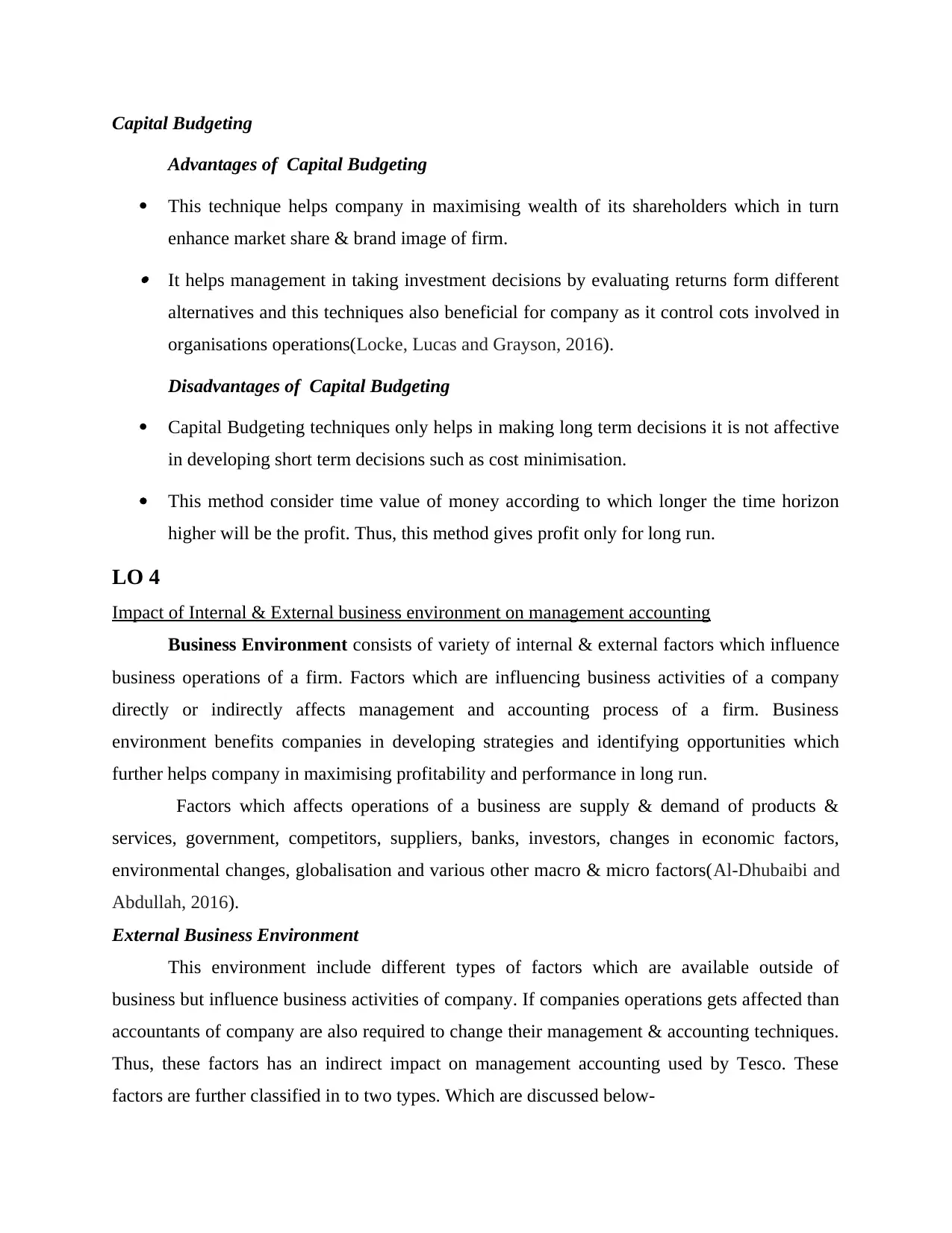
Capital Budgeting
Advantages of Capital Budgeting
This technique helps company in maximising wealth of its shareholders which in turn
enhance market share & brand image of firm. It helps management in taking investment decisions by evaluating returns form different
alternatives and this techniques also beneficial for company as it control cots involved in
organisations operations(Locke, Lucas and Grayson, 2016).
Disadvantages of Capital Budgeting
Capital Budgeting techniques only helps in making long term decisions it is not affective
in developing short term decisions such as cost minimisation.
This method consider time value of money according to which longer the time horizon
higher will be the profit. Thus, this method gives profit only for long run.
LO 4
Impact of Internal & External business environment on management accounting
Business Environment consists of variety of internal & external factors which influence
business operations of a firm. Factors which are influencing business activities of a company
directly or indirectly affects management and accounting process of a firm. Business
environment benefits companies in developing strategies and identifying opportunities which
further helps company in maximising profitability and performance in long run.
Factors which affects operations of a business are supply & demand of products &
services, government, competitors, suppliers, banks, investors, changes in economic factors,
environmental changes, globalisation and various other macro & micro factors(Al-Dhubaibi and
Abdullah, 2016).
External Business Environment
This environment include different types of factors which are available outside of
business but influence business activities of company. If companies operations gets affected than
accountants of company are also required to change their management & accounting techniques.
Thus, these factors has an indirect impact on management accounting used by Tesco. These
factors are further classified in to two types. Which are discussed below-
Advantages of Capital Budgeting
This technique helps company in maximising wealth of its shareholders which in turn
enhance market share & brand image of firm. It helps management in taking investment decisions by evaluating returns form different
alternatives and this techniques also beneficial for company as it control cots involved in
organisations operations(Locke, Lucas and Grayson, 2016).
Disadvantages of Capital Budgeting
Capital Budgeting techniques only helps in making long term decisions it is not affective
in developing short term decisions such as cost minimisation.
This method consider time value of money according to which longer the time horizon
higher will be the profit. Thus, this method gives profit only for long run.
LO 4
Impact of Internal & External business environment on management accounting
Business Environment consists of variety of internal & external factors which influence
business operations of a firm. Factors which are influencing business activities of a company
directly or indirectly affects management and accounting process of a firm. Business
environment benefits companies in developing strategies and identifying opportunities which
further helps company in maximising profitability and performance in long run.
Factors which affects operations of a business are supply & demand of products &
services, government, competitors, suppliers, banks, investors, changes in economic factors,
environmental changes, globalisation and various other macro & micro factors(Al-Dhubaibi and
Abdullah, 2016).
External Business Environment
This environment include different types of factors which are available outside of
business but influence business activities of company. If companies operations gets affected than
accountants of company are also required to change their management & accounting techniques.
Thus, these factors has an indirect impact on management accounting used by Tesco. These
factors are further classified in to two types. Which are discussed below-
⊘ This is a preview!⊘
Do you want full access?
Subscribe today to unlock all pages.

Trusted by 1+ million students worldwide
1 out of 19
Related Documents
Your All-in-One AI-Powered Toolkit for Academic Success.
+13062052269
info@desklib.com
Available 24*7 on WhatsApp / Email
![[object Object]](/_next/static/media/star-bottom.7253800d.svg)
Unlock your academic potential
Copyright © 2020–2025 A2Z Services. All Rights Reserved. Developed and managed by ZUCOL.





